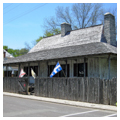This raised house, one of Ste. Genevieve's oldest and a superb example of poteaux-sur-sole construction, has walls of hewn white oak timbers on a base of stones, set approximately six inches apart, and infilled with bousillage. The roof structure is a Norman truss with triangular braces pegged into place which pitches to encompass the wraparound gallery. The plan consists of a broad hall separating the house's two rooms: an all-purpose living area (salle) and a smaller bedroom, each with its own chimney, one at the end and one in the center. A steep staircase leads to the enclosed attic. The basement, with dirt floor, accommodated animals and storage. In c. 1850, the gallery's northwest corner was enclosed to accommodate a kitchen. Bolduc, a French Canadian, became wealthy from mining, trading, and agriculture; his descendants lived in the house until 1949. A restoration begun in 1956 by Ernest A. Connally, who later became associate director at the National Park Service, was criticized as historical re-creation, notably the addition of a freestanding stone kitchen in the rear yard and a stockade fence. The house is now operated by the National Society of the Colonial Dames of America. Directly across Main Street is the timber-framed Gemien Bauvais House (1811), also called the Linden House for the giant specimen that shades the property.
You are here
Louis Bolduc House
c. 1793; 1956 restored. 123 S. Main St.
Coordinator:
Osmund Overby, Carol Grove, and Cole Woodcox
If SAH Archipedia has been useful to you, please consider supporting it.
SAH Archipedia tells the story of the United States through its buildings, landscapes, and cities. This freely available resource empowers the public with authoritative knowledge that deepens their understanding and appreciation of the built environment. But the Society of Architectural Historians, which created SAH Archipedia with University of Virginia Press, needs your support to maintain the high-caliber research, writing, photography, cartography, editing, design, and programming that make SAH Archipedia a trusted online resource available to all who value the history of place, heritage tourism, and learning.

















